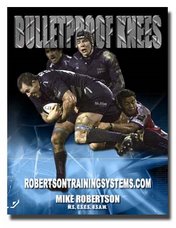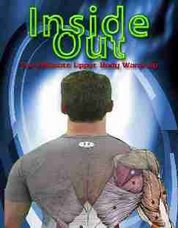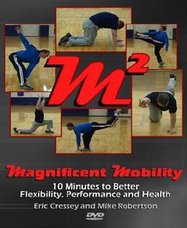I hope you enjoy it - and don't forget, the Indy Seminar DVD's are on sale this week only! Check them out here:
www.IndyPerformanceSeminars.com
As always, thanks for your support over the years - I couldn't do it without you!
Stay strong
MR
___________________________________________________________________
My Training Philosophy
Mike Robertson
Mike Robertson
In the midst of the Internet craze, anyone and everyone can be an expert on training. You can write articles, blog, or just tell everyone on an internet forum how you’re squatting 7 bills for reps. In fact, you’re so jacked that your username is “Squatzilla 5000.” If anyone should dare challenge your thought processes, you’ll quickly flame them into oblivion.
While I enjoy writing, speaking and developing products, the thing I enjoy the most is actually training people. I’m the first to admit that I’m not perfect, but I will always strive to be the best coach or trainer my clients can work with.
I really started focusing on my training philosophy while developing content for my Aussie Seminar Series and my Indianapolis Performance Enhancement Seminar. I asked myself, what are the guiding, big-bang thoughts that constituted how I train people? And not just what I believed in, but why I believed it to be true as well. The same words kept coming up in every presentation, and I soon began to realize how important they are to my philosophy.
Let’s be honest: It’s really easy to sit behind a computer screen, take someone’s words out of context, and talk about how little they know about training. It’s a whole different ball game when it comes down to what you really know and believe in, and being able to explain or defend it to other coaches, trainers and therapists.
Whether you’re a personal trainer, strength coach, physical therapist, or just someone who likes to hit the iron, you’ve to some degree developed your own philosophy with regards to training. What works, what doesn’t, etc. But what are the key components of this philosophy? And how did you come to those conclusions?
Here are four of the key components that I keep coming back to. I hope you enjoy it!
Component #1 – Rationale
Rationale is the basis for your program design. Quite simply, how bulletproof do you believe your programming to be?
Think about it like this; let’s say you’ve written a program for yourself, and I sit down right next to you to look things over. Could you tell me exactly why you chose:
- A specific exercise?
- A specific set/rep scheme?
- A specific time under tension?
- A specific rest period?
To take it a step further, in what instances would you choose a front squat over a back squat? In what cases would 5x5 be superior to 3x8 or 3x10? For which athletes would a 5-10 minute rest between sets be necessary? The point I’m getting at is we need to understand all the variables associated with creating a program, and then understand how manipulating any (or all of) those variables can either improve upon or detract from the quality of the program.
In the case of a powerlifter, a 5x5 program may be ideal to help them build their squat. But if you put them on a 60 or 90 second rest period, you’re going to kill them.
3x8 or 3x10 set/rep schemes may work perfectly in a fat loss setting, but if you allow them 3-5 minutes rest between sets you lose a lot of the training effect.
As you can see from the above examples, you have to think big picture – how all the variables involved influence each other.
As well, far too often we put unnecessary or unneeded “filler” exercises into our programming. Nothing that we do should be arbitrary. If you can’t explain why you do something, why are you doing it?
Component #2 – Progression
Good programming is imperative to long-term success. Progression is one component of good programming.
When starting with a new client or athlete, the first thing we do is assess them. Whether it’s taking their body fat, doing a 1-RM squat, or just watching them play their sport, we have to know where they are starting from first and foremost. As they saying goes, “If you’re not assessing, you’re guessing.”
The assessment is absolutely critical with regards to progression – if you don’t assess them, how do you know where to start? If everyone starts on the same program, it will be just right for some. However, for the vast majority that same programming could be either too easy or too damn hard.
But more importantly, once we know where to start from, the real key is knowing how to get them from where they’re at to where they want to go. Again, whether their goal is to get from 20% body fat to 15% body fat, or to take them from a 275# bench press to 300#, the key is in progression. We all know that what helps you lose the first 20 lbs. won’t help you lose the last 20. Thus, progression is critical.
With that being said, however, I don’t want to imply that the only way to incorporate progression into a training program is to add weight to the bar. Even though I haven’t competed in a while I still have a powerlifters mentality; in more cases than not, more weight on the bar is a good thing. However, they are tons of different variables that we can “progress” upon throughout a training program. Here are a few examples:
- Stability Demands
Beginners generally have poor stability in single-leg stance. We can give them more stability up front (via a split squat) and then progress them into exercises with greater stability demands (reverse lunges, forward lunges, and even walking lunges).
- Exercise Difficulty/Complexity
- Exercise Difficulty/Complexity
With the Olympic lifts, it’s much easier to teach the lifts in small chunks or phases versus having someone clean from the floor on their first session. Start with basics like the hang pull or power clean, and then progress in difficulty from there. If even the basic Olympic moves are too difficult, you can regress back to a med ball throw or KB swing to begin the progression.Another example would be to start clients out using a box to learn how to squat; once they’re comfortable with the torso position and “sitting back,” you can progress them to a traditional back squat from there.
- Decreased rest periods
If someone is doing metabolic based resistance training, a “progression” would be to decrease the rest periods between sets.
- Increased repetitions per set
Again, using a metabolic based resistance training program you may keep the weight on the bar the same, but add repetitions to the set.
- Increasing the time under tension (TUT)
A set of squats performed at a 2-0-1 tempo is much different than that same set of squats performed at a 4-0-1 tempo.
- Increasing the density/pressure of a soft-tissue implement
By moving from a white foam roller to a black one, or from a tennis ball to a lacrosse ball, you increase the intensity of the soft-tissue work.
As you can see, there are various methods of progressing or increasing the intensity of a training program without manipulating the weight on the bar. Adding load isn’t a bad thing whatsoever, but I want you start thinking about how you can apply the concept of progression throughout all the components of your workouts.
Component #3 – Efficiency
Efficiency isn’t a word that we use a lot in this industry, and I hope it will change in the future. Quite simply, if we can complete the same athletic task using, A) more energy, or B) less energy, which sounds better to you?
When it comes to efficiency with regards to training/competing, I phrase it like this:
- The right muscle(s)
- Working at the right time
- With an appropriate level of strength
When we have all these things working together, we not only improve our performance but decrease the likelihood of injury. As Bill Hartman has noted numerous time, we shouldn’t look at these as separate and individual outcomes – rather, they should be looked at as one and the same.
Efficiency, however, is one elusive property to get your hands on. In our “Building the Efficient Athlete” DVD Series, Eric often talks about the difference between inefficiencies and pathologies. Inefficiencies are those minor “hiccups” when it comes to our performance. However, enough of these “hiccups” eventually lead to injury, or at the very least sub-maximal performance.
This is where people need to understand the roles of both activation/motor control work and strength work. Intelligent program design will incorporate activation/motor control to get those little muscle groups firing (i.e. low traps, serratus, gluteals, psoas, etc.). However, once you’ve learned how to utilize them, the key is to get them stronger and working within normal movement patterns.
One thing that pisses me off is when people try and say I do “too much” activation work. Look, you can call it activation, motor control, facilitation, whatever. The bottom line is this: If someone can’t recruit a muscle group in isolation, then how in the hell are they going to recruit it in a multi-joint movement pattern?
Answer: It doesn’t happen.
So if your glutes don’t fire in a bridge, you can do pause squats in the hole until your fucking blue in the face and they aren’t going to turn on, either. Sorry.
This is the whole premise behind isolation to integration. Teach them to use the glutes in an isolated setting. Once they’re working, then take them to a “bridge the gap” type exercise like a mini-band resisted squat or RNT based lunge. I discussed these previously in my Hardcore Lunge article. Once you’ve learned to activate the muscle group within an exercise like this, it’s time to re-learn the exercise in its original fashion.
The bottom line is this: I’m all for optimizing training. It may take three sets or none when it comes to activation drills, and the truth it I don’t care. The only thing I’m focused on is the end-result or outcome. Efficiency is a moving target, just like the goals of your clients and athletes. The sooner you release yourself from training dogma and black and white thinking, the better off you’ll be.
Component #4 – Symmetry
The final component of my training philosophy is striving to achieve symmetry. The more symmetrical we are, in my opinion, the less likely we are to get injured.
But “symmetry” is very vague; what exactly are we looking for symmetry in? And no, I’m not talking about balancing your inner thigh “sweep” to your outer thigh bulk, or developing your inner vs. outer pecs.
Instead, I’m looking for symmetry in three regards:
- Mobility/Movement Capacity
- Motor Control
- Strength
Let’s look at each individual factor a little bit more in depth.
We know that mobility is important, but what about symmetry of movement between sides? Doesn’t it make sense that we should have the same amount of ankle mobility from side-to-side if we want a symmetrical squat? What about hip mobility? Or thoracic spine mobility? The things we do in the weight room are generally symmetrical in nature – so why wouldn’t we want symmetry with regards to our mobility and movement capacity?
Next, we have motor control. Quite often, we’ll see asymmetries with regards to someone’s ability to recruit their serratus, low traps, gluteals, etc. Again, knowing that what we do in the gym is inherently bilateral in nature, it only makes sense to have those “right” muscles working for us.
Finally, we come to strength. Guys like Eric Cressey, Michael Boyle and myself have been talking about the need for single-leg work for years. But it goes beyond just single leg work – what about single arm upper extremity work as well? Or core development? Just some things to start thinking about.
One thing I’d like to mention here is this: Sports are inherently asymmetrical. What makes a pitcher really good at throwing, or what makes a basketball player really good at jumping off one leg leads them to built-in asymmetries. If you’re a strength coach or personal trainer, your goal in the weight room (or on the field) is to keep them healthy and at the top of their sport. Rather than subscribing to the dogma that “every athlete must squat” or “every athlete will bench 300 pounds,” do your best to keep their asymmetries under control, while not taking away the natural skills or traits that make them a great athlete. This article is geared more towards the weight-room enthusiast, however, so I’ll step off my soap box now.
Being as “symmetrical” as possible may not take us very far with regards to immediate gratification and adding weight to the bar. It will, however, keep us healthy over the long haul. After all, you can’t push the limits if you’re always injured. By working on asymmetries you allow yourself the possibility of getting stronger, over a longer period of time, than you ever dreamed.
And that, my friends, is pretty darn cool.
Summary
Developing your own philosophy is one of the most important things you can do as a trainer, therapist and coach. Do your best to define not just what you believe in, but why as well. And finally, realize that this is an ongoing process.
About the Author
Mike Robertson, M.S., C.S.C.S., U.S.AW., has helped clients and athlete from all walks of life achieve their strength, physique and performance related goals. Mike received his Masters Degree in Sports Biomechanics from the world-renowned Human Performance Lab at Ball State University.
Mike is the president of Robertson Training Systems and the co-owner of Indianapolis Fitness and Sports Training in Indianapolis, Indiana.
As you can see, there are various methods of progressing or increasing the intensity of a training program without manipulating the weight on the bar. Adding load isn’t a bad thing whatsoever, but I want you start thinking about how you can apply the concept of progression throughout all the components of your workouts.
Component #3 – Efficiency
Efficiency isn’t a word that we use a lot in this industry, and I hope it will change in the future. Quite simply, if we can complete the same athletic task using, A) more energy, or B) less energy, which sounds better to you?
When it comes to efficiency with regards to training/competing, I phrase it like this:
- The right muscle(s)
- Working at the right time
- With an appropriate level of strength
When we have all these things working together, we not only improve our performance but decrease the likelihood of injury. As Bill Hartman has noted numerous time, we shouldn’t look at these as separate and individual outcomes – rather, they should be looked at as one and the same.
Efficiency, however, is one elusive property to get your hands on. In our “Building the Efficient Athlete” DVD Series, Eric often talks about the difference between inefficiencies and pathologies. Inefficiencies are those minor “hiccups” when it comes to our performance. However, enough of these “hiccups” eventually lead to injury, or at the very least sub-maximal performance.
This is where people need to understand the roles of both activation/motor control work and strength work. Intelligent program design will incorporate activation/motor control to get those little muscle groups firing (i.e. low traps, serratus, gluteals, psoas, etc.). However, once you’ve learned how to utilize them, the key is to get them stronger and working within normal movement patterns.
One thing that pisses me off is when people try and say I do “too much” activation work. Look, you can call it activation, motor control, facilitation, whatever. The bottom line is this: If someone can’t recruit a muscle group in isolation, then how in the hell are they going to recruit it in a multi-joint movement pattern?
Answer: It doesn’t happen.
So if your glutes don’t fire in a bridge, you can do pause squats in the hole until your fucking blue in the face and they aren’t going to turn on, either. Sorry.
This is the whole premise behind isolation to integration. Teach them to use the glutes in an isolated setting. Once they’re working, then take them to a “bridge the gap” type exercise like a mini-band resisted squat or RNT based lunge. I discussed these previously in my Hardcore Lunge article. Once you’ve learned to activate the muscle group within an exercise like this, it’s time to re-learn the exercise in its original fashion.
The bottom line is this: I’m all for optimizing training. It may take three sets or none when it comes to activation drills, and the truth it I don’t care. The only thing I’m focused on is the end-result or outcome. Efficiency is a moving target, just like the goals of your clients and athletes. The sooner you release yourself from training dogma and black and white thinking, the better off you’ll be.
Component #4 – Symmetry
The final component of my training philosophy is striving to achieve symmetry. The more symmetrical we are, in my opinion, the less likely we are to get injured.
But “symmetry” is very vague; what exactly are we looking for symmetry in? And no, I’m not talking about balancing your inner thigh “sweep” to your outer thigh bulk, or developing your inner vs. outer pecs.
Instead, I’m looking for symmetry in three regards:
- Mobility/Movement Capacity
- Motor Control
- Strength
Let’s look at each individual factor a little bit more in depth.
We know that mobility is important, but what about symmetry of movement between sides? Doesn’t it make sense that we should have the same amount of ankle mobility from side-to-side if we want a symmetrical squat? What about hip mobility? Or thoracic spine mobility? The things we do in the weight room are generally symmetrical in nature – so why wouldn’t we want symmetry with regards to our mobility and movement capacity?
Next, we have motor control. Quite often, we’ll see asymmetries with regards to someone’s ability to recruit their serratus, low traps, gluteals, etc. Again, knowing that what we do in the gym is inherently bilateral in nature, it only makes sense to have those “right” muscles working for us.
Finally, we come to strength. Guys like Eric Cressey, Michael Boyle and myself have been talking about the need for single-leg work for years. But it goes beyond just single leg work – what about single arm upper extremity work as well? Or core development? Just some things to start thinking about.
One thing I’d like to mention here is this: Sports are inherently asymmetrical. What makes a pitcher really good at throwing, or what makes a basketball player really good at jumping off one leg leads them to built-in asymmetries. If you’re a strength coach or personal trainer, your goal in the weight room (or on the field) is to keep them healthy and at the top of their sport. Rather than subscribing to the dogma that “every athlete must squat” or “every athlete will bench 300 pounds,” do your best to keep their asymmetries under control, while not taking away the natural skills or traits that make them a great athlete. This article is geared more towards the weight-room enthusiast, however, so I’ll step off my soap box now.
Being as “symmetrical” as possible may not take us very far with regards to immediate gratification and adding weight to the bar. It will, however, keep us healthy over the long haul. After all, you can’t push the limits if you’re always injured. By working on asymmetries you allow yourself the possibility of getting stronger, over a longer period of time, than you ever dreamed.
And that, my friends, is pretty darn cool.
Summary
Developing your own philosophy is one of the most important things you can do as a trainer, therapist and coach. Do your best to define not just what you believe in, but why as well. And finally, realize that this is an ongoing process.
About the Author
Mike Robertson, M.S., C.S.C.S., U.S.AW., has helped clients and athlete from all walks of life achieve their strength, physique and performance related goals. Mike received his Masters Degree in Sports Biomechanics from the world-renowned Human Performance Lab at Ball State University.
Mike is the president of Robertson Training Systems and the co-owner of Indianapolis Fitness and Sports Training in Indianapolis, Indiana.









No comments:
Post a Comment